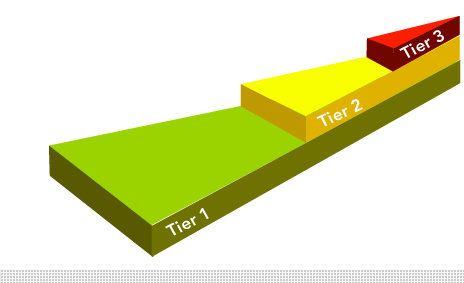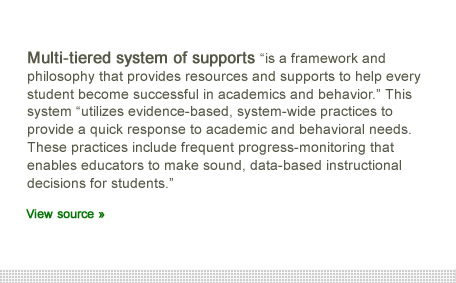 |
 |
 |
 |
 |
 |
 |
 |
 |
 |
 |
 |
 |
 |
 |
A multi-tiered system of supports helps divisions, schools and classrooms get READY ready to support academic and behavioral growth in students through effective, data driven problem solving and decisions to ensure that an effective education for all students can be achieved.
Getting READY includes commitment to:
| |
• Universal Screening |
| |
• Progress-monitoring |
| |
• Data driven decisions |
| |
(National Center on Response to Intervention, April 2010) |
|
 |
 |
 |
Multi-tiered system of supports, common to both Positive Behavioral Interventions & Supports (PBIS) and Response to Intervention (RtI), SET in motion the implementation of evidence-based practices at each tier. School personnel
get SET by creating clear tier definitions and mapping the supports offered at each tier. For example, tiered definitions might be:
| |
• Tier 1: core universal academic and behavior interventions that ALL students receive, and to which 80-90% of students respond |
| |
• Tier 2: targeted academic and/or behavior interventions that some students (5-10%) receive in addition to Tier 1 |
| |
• Tier 3: those intensive academic and/or behavior interventions few students (1-5%) receive in addition to Tier 1 and 2 |
| |
View Source »
|
With clear tier definitions in place, school personnel can then map what assessments, resources and evidence-based practices match student need at each tier.
|
 |
 |
 |
To learn more about multi-tiered system of supports and implementation, GO to:
| |
• The Virginia Department of Education (VDOE) resource link on tiered instruction. |
| |
View Source »
|
| |
• Positive Behavioral Interventions & Supports: OSEP Technical Assistance Center established by the U.S. Department of Education's Office of Special Education Programs (OSEP) to define, develop, implement, and evaluate a multi-tiered approach to Technical Assistance that improves the capacity of states, districts and schools to establish, scale-up and sustain the PBIS framework. Emphasis is given to the impact of implementing PBIS on the social, emotional and academic outcomes for students with disabilities. |
| |
• The Response to Intervention Action Network is designed to provide educators with information about the essential components of a multi-tiered framework. Educators will learn how RtI sets the stage for learning through developing a responsive plan matched to student needs. The site includes online learning modules and options to link users to additional resources. |
|
 |
 |
|
References:
• National Center on Response to Intervention. (April 2010) Essential Components of RTI - A Closer Look at Response to Intervention. Washington, DC: U.S. Department of Education, Office of Special Education Programs, National Center on Response to Intervention.
View Source »
• The Virginia Department of Education (VDOE) resource link on tiered instruction. View Source»
• Positive Behavioral Interventions & Supports (PBIS). (2014) RTI: Response to Intervention (RTI) & PBIS: What is Response to Intervention? U.S. Office of Special Education Programs Technical Assistance Center. View Source » |
This news brief is a collaborative effort of the Virginia Department of Education Training and Technical Assistance Centers at George Mason University and James Madison University. This issue was prepared by the staff of the VDOE TTAC at George Mason University. For questions about content, please contact
Janet Ratzlaff at jratzlaf@gmu.edu,
Karen Berlin at kberlin@gmu.edu
or Kay Klein at mklei1@gmu.ed
or
call 703-993-4496.
|
|
 |
 |
 |
 |
 |







